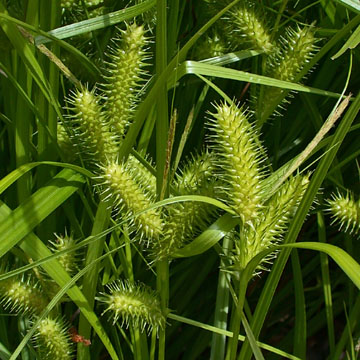

Carex lurida - (image 1 of 4)
Taxonomy
Family: Cyperaceae
Habitat
Swamps, wet meadows, bogs, peaty fens.
Associates
Distribution
Nova Scotia west to MN, south to FL and Mexico.
Morphology
Tufted perennial to 1 m from short rhizomes; stems with the lower leaves reduced to scales, usually surpassed by the leaves, obtusely trigonous and smooth, purplish at the base; leaves septate-nodulose; blade flat, 4-6 mm wide; ligule triangular, longer than wide; terminal spike staminate, 1-7 cm long, the scales awned; pistillate spikes 1-4, sessile and erect or with the lower evidently pedunculate and sometimes nodding, to 7.5 cm long and 2 cm wide, densely flowered; bracts leafy, exceeding the inflorescence, with or without a sheathing base; pistillate scales tapering to an abrupt, serrulate awned tip; perigynia in many rows, 6-9 mm, ovoid to ovoid-globose, inflated, pale, shiny, the beak slender and bidentate, half to almost as long as the body; achenes trigonous, granular; styles persistent, twisted or abruptly bent.
Notes
Fruiting late May to July
Wetland indicator: OBL
A very common species, particularly in disturbed areas of moist woods. Also called Bottlebrush Sedge, but there are other sedges given this name (C. comosa and C. hystericina). The latter is similar but has at least the lowest pistillate spike spreading or drooping on a slender peduncle. Carex baileyi looks very much like C. lurida but has narrower leaves and longer, more abruptly beaked perigynia.
References
Curtis, L. 2006. Woodland Carex of the upper Midwest. Lake Villa, IL.
Gleason, Henry A. and A. Cronquist. 1991. Manual of Vascular Plants of
Northeastern United States and Adjacent Canada. Second Ed.
The New York Botanical Garden. Bronx, NY
Swink, F. and G. Wilhelm. 1994. Plants of the Chicago Region.
Indiana Academy of Science. The Morton Arboretum. Lisle, Illinois.
|
© Michael Hough 2009 |